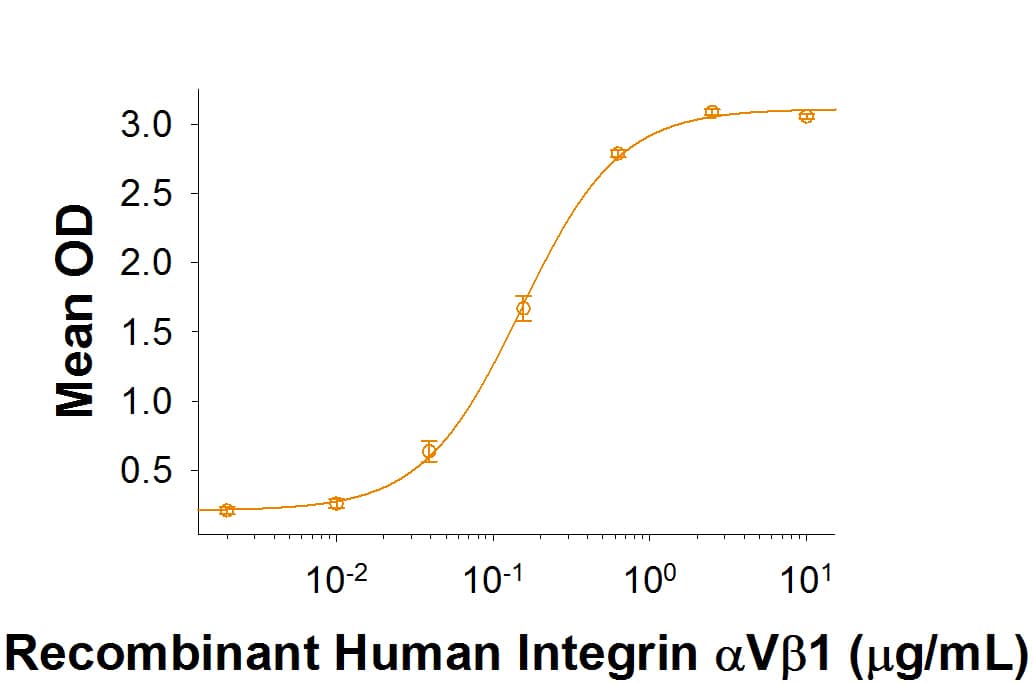Recombinant Human Integrin alpha V beta 1 Protein, CF
R&D Systems, part of Bio-Techne | Catalog # 6579-AVB

Key Product Details
Source
Structure / Form
Conjugate
Applications
Product Specifications
Source
| Human Integrin alpha
V (Phe31-Val992) Accession # NP_002201 |
GGGSGGGSGGGS | Acidic Tail | HHHHHH |
| Human
Integrin beta 1 (Gln21-Asp728) Accession # P05556 |
GGGSGGGSGGGS | Basic Tail | |
| N-terminus | C-terminus | ||
Purity
Endotoxin Level
N-terminal Sequence Analysis
Predicted Molecular Mass
SDS-PAGE
Activity
When Recombinant Human Fibronectin (Catalog # 4305-FNB) is immobilized at 2 μg/mL, 100 μL/well, Recombinant Human Integrin alphaV beta1 binds with an ED50 of 0.08-0.48 μg/mL.
Scientific Data Images for Recombinant Human Integrin alpha V beta 1 Protein, CF
Recombinant Human Integrin alpha V beta 1 Protein Binding Activity
When Recombinant Human Fibronectin (Catalog # 4305-FNB) is coated at 2 µg/mL Recombinant Human Integrin aV beta1 (Catalog # 6579-AVB) binds with an ED50 of 0.08-0.48 µg/mL.Formulation, Preparation and Storage
6579-AVB
| Formulation | Lyophilized from a 0.2 μm filtered solution in PBS with Trehalose. |
| Reconstitution | Reconstitute at 500 μg/mL in water. |
| Shipping | The product is shipped at ambient temperature. Upon receipt, store it immediately at the temperature recommended below. |
| Stability & Storage | Use a manual defrost freezer and avoid repeated freeze-thaw cycles.
|
Background: Integrin alpha V beta 1
Integrin alphaV beta1 is one of five alphaV and twelve beta1 containing Integrin family adhesion receptor heterodimers (1‑3). The non-covalent heterodimer of 170 kDa alphaV and 130 kDa beta1/CD29 is present on cells that express both subunits, and dimer formation is dependant on the availability of the individual subunits (4). Since the alphaV and beta1 subunits are widely expressed, the alphaV beta1 heterodimer potentially forms in many cell types. The 962 aa human alphaV extracellular domain (ECD) shares 92‑95% aa sequence identity with mouse, rat and bovine alphaV, while the 708 aa human beta1 ECD shares 92‑96% aa sequence identity with mouse, rat, bovine and feline beta1. The alphaV ECD contains an N‑terminal beta‑propeller structure, followed by domains termed thigh, calf-1 and calf-2 (1). The beta1 ECD contains a vWFA domain, which participates in binding. Each subunit then has a transmembrane sequence and a short cytoplasmic tail. The dimer is folded when it is least active. Divalent cations and intracellular (inside-out) signaling convert it to its most active, extended and open conformation (1). alphaV integrins bind ligands that contain an RGD motif, including vitronectin, fibronectin and osteopontin (4‑9). The relatively weak binding affinity of alphaV beta1 to vitronectin and fibronectin is thought to facilitate its activity in cyclic binding and release during cell migration (4, 5). In oligodendrocytes, astrocytes and pancreatic beta cells, alphaV beta1 is expressed early in differentiation when cells are migrating and is down‑regulated when differentiation is complete (5‑7). alphaV beta1 has also been found to be a receptor for angiopoietin-2 in Tie2-deficient glioma cells, and to mediate cell entry of viruses such as foot‑and‑mouth disease virus and human metaneumovirus (10‑12).
References
- Hynes, R. O. (2002) Cell 110:673.
- Suzuki, S. et al. (1987) J. Biol. Chem. 262:14080.
- Argraves, W.S. et al. (1987) J. Cell Biol. 1025:1183.
- Koistinen, P. and J. Heino (2002) J. Biol. Chem. 277:24835.
- Kaido, T. et al. (2004) J. Biol. Chem. 279:17731.
- Milner, R. et al. (1996) J. Neurosci. 16:7240.
- Milner, R. et al. (2001) Mol. Cell. Neurosci. 18:108.
- Koivisto, L. et al. (2000) Exp. Cell Res. 255:10.
- Hu, D.D. et al. (1995) J. Biol. Chem. 270:26232.
- Hu, B. et al. (2006) Cancer Res. 66:775.
- Jackson, T. et al. (2002) J. Virol. 76:935.
- Cseke, G. et al. (2009) Proc. Natl. Acad. Sci. USA 106:1566.
Alternate Names
Entrez Gene IDs
Gene Symbol
Additional Integrin alpha V beta 1 Products
Product Documents for Recombinant Human Integrin alpha V beta 1 Protein, CF
Product Specific Notices for Recombinant Human Integrin alpha V beta 1 Protein, CF
For research use only
